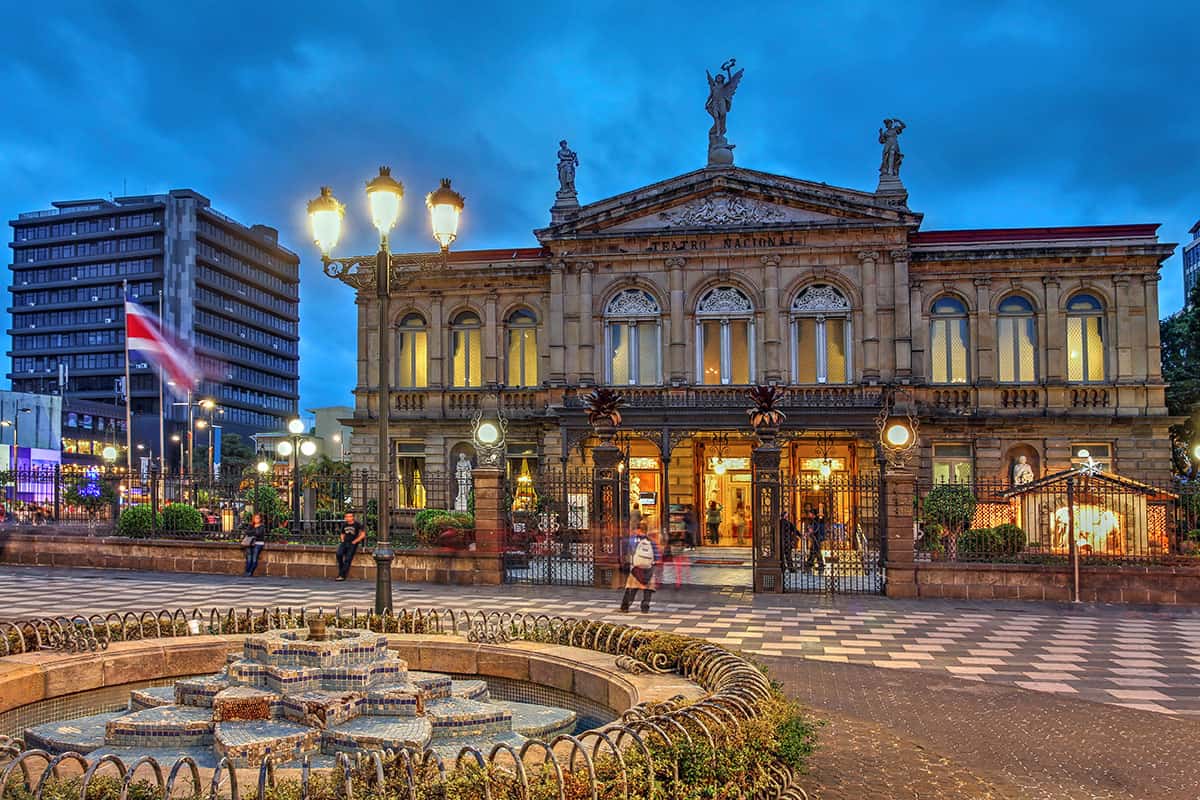In an expression both illustrative and ironic, Costa Ricans today still refer to their country as a “coffee plantation with telephones.” Perhaps a “coffee plantation with theaters” would be more fitting.
On a recent Saturday, I took it upon myself to count how many plays were showing in San José. The result: 24 theaters – government, private and university – opened their doors to the public that night. Surprising for a small Central American city; surprising to those ignorant of this country’s old and deep-rooted passion for theater. It is not for nothing that the National Theater is a national icon; not so long ago, it was not unusual to see a barefoot campesino on a visit to the capital take off his hat and cross himself at the sight of it.
Of course, the quality of San José’s theater offerings is variable. But the variety reveals the passion for the performing arts that pervades this country.
A Little History
It is significant that at the end of the 19th century Costa Rican coffee exporters built a theater and not a military barracks, racetrack or social club. Construction of the National Theater was financed by a tax on every sack of coffee exported, and its inauguration in 1897 was intended to place San José on the circuit of theater, opera and zarzuela company tours that frequented both sides of the Atlantic in those years.
Even before the National Theater was built, President Juan Rafael Mora (1849-1859) – leader of Costa Rica’s forces in Central America’s war against William Walker and his filibuster army – ordered the construction of what was then called the “Mora Theater,” which opened its doors to San José audiences in 1851.
In 1857, 17 U.S. filibusters, after being prisoners of war, withdrew to San José and had to to earn their bread by going onstage as comics in that theater. According to researcher Álvaro Rojas, “For five months, the 17 soldier-prisoners strained their imaginations to entertain the people of San José with all kinds of foul-mouthed improvisations on the large stage, using lower-class English and broken Spanish.” This is the first documented case of a U.S. theater group in Costa Rica.
Also predating the National Theater is the Variedades Theater, known today as Cine Variedades. It opened its doors in 1891 and has since been remodeled several times.
The inauguration of the National Theater allowed foreign companies to present their works with dignity in San José, and also fostered local productions. The first plays written by Costa Ricans are those of the “Olympus Generation,” so called for their close ties to the political elite of the late 19th and early 20th centuries.
The best known of these works is perhaps “Magdalena,” by playwright and historian Ricardo Fernández Guardia, which premiered at the National Theater in 1902. The play’s title character is a young woman from a wealthy family who, after visiting France, returns to Costa Rica with her head full of eccentric ideas, convinced of the uselessness of marriage or, more precisely, of its use as a tool to subjugate women.
Other Tico playwrights such as José Fabio Garnier, Carlos Gagini and Eduardo Calsamiglia wrote dramas, comedies and sainetes (one-act farces), which were performed in San José theaters by the same foreign companies that brought shows from abroad, perhaps as a way for them to ingratiate themselves with local audiences.
Going Professional
It was not until the mid-20th century that the first initiatives arose to form more or less stable and professional theater groups in Costa Rica. The first of these was created under the auspices of the University of Costa Rica (UCR) and was – and still is – called Teatro Universitario.
Founded in 1950, TU, as it is also known, aimed to be a professional and permanent theater group. In addition to creating a theater department, the UCR provided resources to hire actors and rented and fitted out a theater for performances. Luccio Ranucci of Italy was the group’s first director. Despite some initial setbacks, the project succeeded and is still active today.
A few years after TU was founded, some of its members and other actors formed the country’s first independent theater group, Teatro Arlequín, in 1957. This was a milestone, Costa Rica’s first semiprofessional and stable theater group, with a regular cast. Names inextricably linked to this period include playwright and director Daniel Gallegos, former Culture Minister Guido Sáenz, late man of theater Lenín Garrido, actress Ana Poltronieri, poet and actress Virginia Grütter, actor and director José Tassies and actor José Trejos, some of whom are still active in theater today, or were until recently.
After the Civil War of 1948, several intellectuals on the winning side of José “don Pepe” Figueres chose theater as a means of expression. Among these were playwrights Samuel Rovinsky and Alberto Cañas. The latter, as the country’s first culture minister, took the first decisive step toward professionalizing theater in Costa Rica by creating the National Theater Company.
The creation of the Culture Ministry in 1971 and the National Theater Company shortly after gave a huge push to Costa Rican theater. In those years – still recalled by some as a “golden age” of theater in the country – the government took a highly active role in promoting the arts and culture in general. Most of the country’s most important public institutions in cultural work, including the National Dance Company, the Costa Rican Center for Film Production and the national theater and dance workshops, were created during this time.
The National Theater Company was formed with a regular cast and regularly invited foreign directors to work in the country. It also organized tours and festivals in San José and beyond. Its repertoire policy sought to combine the classical and the contemporary, the experimental and the traditional, the universal and the national.
The South American Exiles
During this time, military dictatorships had installed a reign of terror in much of South America. From Chile, Argentina and Uruguay, men and women of theater and the arts came to Costa Rica as refugees and political exiles, or simply to put a safe distance between themselves and their turbulent native countries.
Coming from more professional and developed theater scenes, the South American exiles gave an enormous push to theater in Costa Rica. Some joined the fledgling National Theater Company; others developed independent theater projects that today are still well-known. Important figures among this group include actors such as Marcelo Gaete, Sara Astica, Alonso Venegas, Carmen Bunster, Rodrigo Durán, Marcia Maiocco, Leonardo Perucci, Rubén Pagura and Juan Katevas. Among the independent theater groups formed by foreigners in Costa Rica, it is essential to mention at least Teatro del Ángel and Teatro Carpa.
In addition to breathing new life into the Costa Rican theater scene, the South American exiles played an important role in the academic and literary fields. While some exiles stayed in Costa Rica only for a while before heading to other countries, others decided to put down roots: Argentines Alfredo and Gladys Catania, Chileans Marcelo Gaete and Sara Astica, and Lucho Barahona, who arrived in Costa Rica with Teatro del Ángel from Chile, and who decided to stay even after his colleagues returned to their home country.
Hard Times
In the 1980s, Costa Rica, along with the rest of Latin America, suffered a severe economic crisis that put the country’s public finances and economy in the red. As often happens in such situations, the arts took a beating.
The number of professionals coming out of theater faculties and schools, both in Costa Rica and abroad, was on the rise, and a new contingent of men and women of theater were seeking ways to make a living. In the face of shrinking government-sponsored initiatives, new and independent theater groups and projects emerged.
Some were founded by new graduates of the country’s two university theater schools; others, by experienced actors who needed a way to survive. Still others were started by young – and sometimes not so young – entrepreneurs seeking to combine their passion for theater with a business undertaking. There were also cases of private companies entering into the world of theater and entertainment, sporadically or through a permanent patronage policy, like Café Britt and BAC San José would later do.
Theater Today
This trend born in the ’80s grew through the ’90s and continues today. And so, at the beginning of the second decade of the 21st century, on a given Saturday night in San José, as many as 24 plays are showing, offering something for every taste: works that have triumphed internationally and are being staged for the first time in Costa Rica, old and contemporary classics, theater for fun or entertainment, experimental and avant-garde offerings, cheap sexy comedies and so on.
In recent years, the government has resumed in part its role as promoter of the performing arts. Important initiatives include the international arts festivals held every two years in the country, offering spectators and artists the chance to appreciate international shows and exchanges with counterparts from abroad. Equally important is the Proartes program, the first and only government fund created to finance independent theater projects.
The theater scene has also been stimulated by new institutions such as the Spanish Cultural Center, the Mexico Institute and the National Auditorium in the Children’s Museum, to name only a few. The opening of the National Theater Company’s La Aduana Theater and the new theater of the UCR School of Dramatic Arts are the final links in this happy chain.
Add to this the construction or adaptation of infrastructure suitable for theater performances in towns and cities across the country – from San Isidro de El General to Liberia, Puntarenas to Limón, Cartago to San Ramón – and a robust community theater movement, and one gets a good picture of the health of theater in Costa Rica today.
Quiet now. That’s the third chime. The show’s about to start…
Rodrigo Soto is a Costa Rican writer who has published more than a dozen books, including novels, short story and poetry collections and plays. He is also a video maker and producer.







